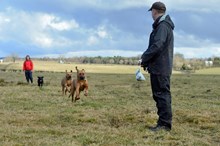12 August, 2015
Taking the Lead - Advice for land managers to encourage responsible dog walking
Dog walkers allowing their dogs to worry livestock or leaving dog dirt behind are problems many farmers, crofters and land owners struggle with every day.
To help with these issues, Scottish Natural Heritage (SNH) has today published “Taking the Lead”, a set of guidance, case studies and information sheets on various ways to encourage dog walkers to behave responsibly on farms, estates and crofts.
Bridget Finton, SNH recreation & access officer, explains:
“Almost 4 million adults visit Scotland’s great outdoors every year, and about 48 percent of those people are accompanied by a dog. These high numbers show how dog walking helps lots of people get healthy outdoor activity, but it’s really important to minimise the number of occasions when dogs cause land managers’ concerns. This guidance aims to influence the behaviour of the minority of dog walkers who act irresponsibly – actions that can have a big impact on livestock and wildlife, as well as those who are trying to enjoy the outdoors without getting dog dirt on their shoes!
“We’ve asked land managers to share the methods they found most effective in their local circumstances, so the lessons they’ve learned can be used by others. We’ve worked hard to make the information as practical as possible, and hope it will be of use to anyone experiencing issues on their land related to access with dogs.”
Gemma Thomson of the National Farmers Union of Scotland (NFUS), said:
“NFUS has been aware of increasing issues experienced by members as a result of dog access. There have been a number high profile instances which have occurred recently. NFUS is pleased to support the guidance, which should go some way to helping some land managers in ensuring that they are clear about access rights, and also assist them in finding innovative ways to address issues where they occur.”
Anne Gray, Policy Officer with Scottish Land & Estates commented:
“A variety of problems related to dog-walking are reported to me every year. These issues range from people not picking-up after their dog has gone to the toilet to dogs disturbing livestock, game birds or wildlife. We hope this guidance will give landowners, farmers and other land managers helpful tips on how to manage dog-walking on their land in a positive and effective way. We want everyone to have a good experience of being out and about in the countryside. To achieve this sometimes requires forethought in term of how messages are communicated and how the right behaviour is encouraged. 'Taking the lead' will help with developing these positive approaches.”
The guidance gives a step-by-step approach, including identifying and assessing the scale of problems, engaging with dog walkers, local authorities and others, applying for funding if required, and implementing, monitoring and reviewing your plans. There are special features, such as how to make it clear to dog walkers where, why and when dogs should be kept on-lead, how dog dirt should be disposed of, and the use of alternate routes.
There is a collection of case studies from 10 estates and farms with advice from the people on the ground, such as Brahan Estate’s experience encouraging dog walkers to use less sensitive areas, which they have found works far better than trying to exclude dogs from certain areas. Another example is Boat of Garten which found that explaining why dogs need to be kept on-lead, in a specific area for a defined time, commanded more respect than demands to keep dogs on-lead at all times.
There is also an information sheet with tips on how to create effective signs for dog walkers, with positive examples and access to free templates for use. For example, signs for lambing season which include specific date ranges and alternate routes were found to be more effective. Other tips cover how to highlight dog fouling problems to users, and how to reduce risks of public access with dogs during lambing season.
To download the ‘Taking the Lead’ guidance, case studies and information sheets, go to http://www.outdooraccess-scotland.com. The series was developed in partnership with NFU Scotland, Scottish Land and Estates, The Kennel Club and The Scottish Kennel Club.
ENDS
For more information, contact Vicki Mowat, SNH PR & Media Officer, on 0131 316 2659 or 07917 071 543 or vicki.mowat@snh.gov.uk or contact the main SNH press office on 01463 725 022.
Contact information
- Name
- SNH Media
- snhmedia@snh.gov.uk
NatureScot is Scotland's nature agency. We work to enhance our natural environment in Scotland and inspire everyone to care more about it. Our priority is a nature-rich future for Scotland and an effective response to the climate emergency. For more information, visit our website at www.nature.scot or follow us on X at https://x.com/NatureScot
’S e NatureScot buidheann nàdair na h-Alba. Bidh sinn a’ neartachadh àrainneachd na h-Alba agus a’ brosnachadh dhaoine gu barrachd suim a chur ann an nàdar. Tha e mar phrìomhachas againn gum bi nàdar na h-Alba beairteach agus gun dèilig sinn gu h-èifeachdach le èiginn na gnàth-shìde. Tha an tuilleadh fiosrachaidh aig www.nature.scot no air X aig https://x.com/NatureScot

